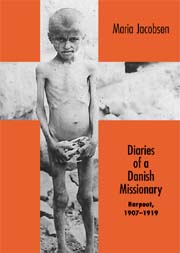
Diaries of a Danish Missionary: Harpoot, 1907-1919
London: Gomidas Institute, 2006
xxii + 266 pp, map,
ISBN 0-903656-07-9, paperback,
UK£24.00 / US$32.00 OUT OF STOCK
UK£36.00 / US$48.00 SPECIAL RESERVE
To order please contact books@gomidas.org
The Gomidas Institute has just released an English translation of the diaries of Maria Jacobsen, a Danish missionary who was in Harpoot in the early part of the twentieth century—including during the genocide of Armenians in 1915. Her diaries constitute another key eyewitness account of the treatment of Armenians in Ottoman Turkey. Jacobsen's diaries were translated from the original Danish by Kristen Vind and edited by Ara Sarafian.
According to Sarafian, Diaries of a Danish Missionary: Harpoot, 1907-1919,is "documentation of the utmost significance" and comparable to the eyewitness accounts of Henry Riggs (Days of Tragedy in Armenia), Tacy Atkinson (The German, the Turk and the Devil Made a Triple Alliance), and the reports filed by U. S. Consul Leslie Davis. However, unlike these American witnesses, who had to leave this region in April 1917 (when the United States entered World War I), Jacobsen carries on her narrative until the end of the war. In this sense it is a more complete record of the Armenian Genocide in Ottoman Turkey.
Maria Jacobsen watched the persecution of Armenians from close quarters and tried to save as many Armenian women and children as she could. She pleaded with the Ottoman authorities, provided clandestine relief, and recorded what she saw. Her diaries are invaluable for a critical understanding of the Armenian Genocide.
« Back to books listing
According to Sarafian, Diaries of a Danish Missionary: Harpoot, 1907-1919,is "documentation of the utmost significance" and comparable to the eyewitness accounts of Henry Riggs (Days of Tragedy in Armenia), Tacy Atkinson (The German, the Turk and the Devil Made a Triple Alliance), and the reports filed by U. S. Consul Leslie Davis. However, unlike these American witnesses, who had to leave this region in April 1917 (when the United States entered World War I), Jacobsen carries on her narrative until the end of the war. In this sense it is a more complete record of the Armenian Genocide in Ottoman Turkey.
Maria Jacobsen watched the persecution of Armenians from close quarters and tried to save as many Armenian women and children as she could. She pleaded with the Ottoman authorities, provided clandestine relief, and recorded what she saw. Her diaries are invaluable for a critical understanding of the Armenian Genocide.